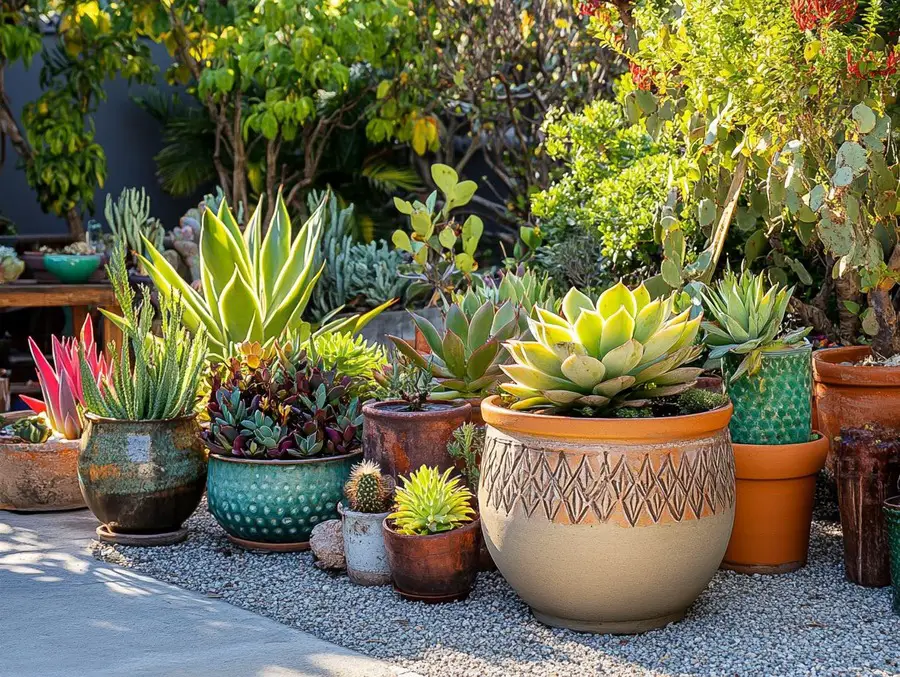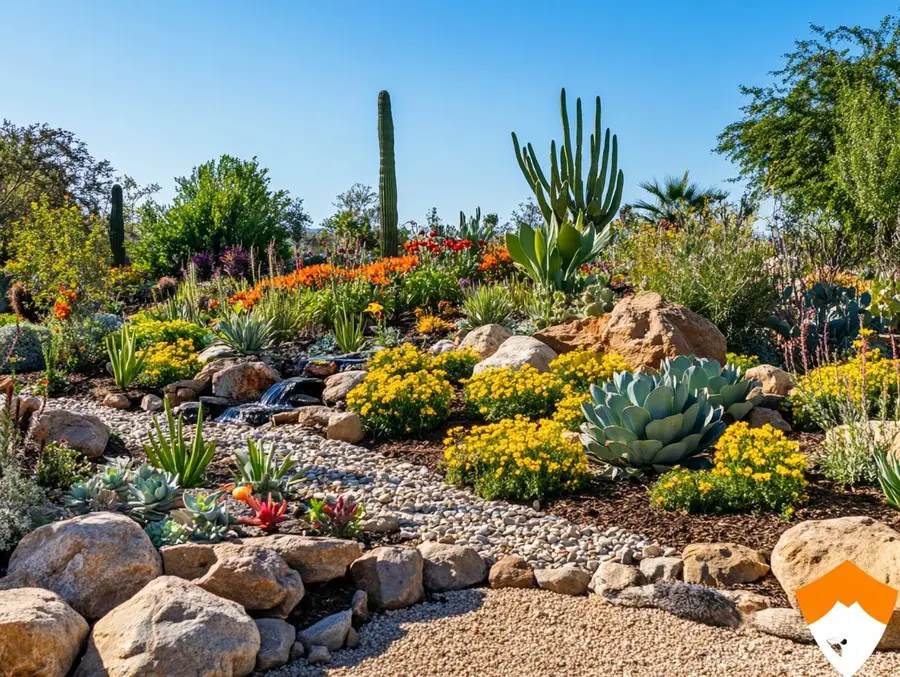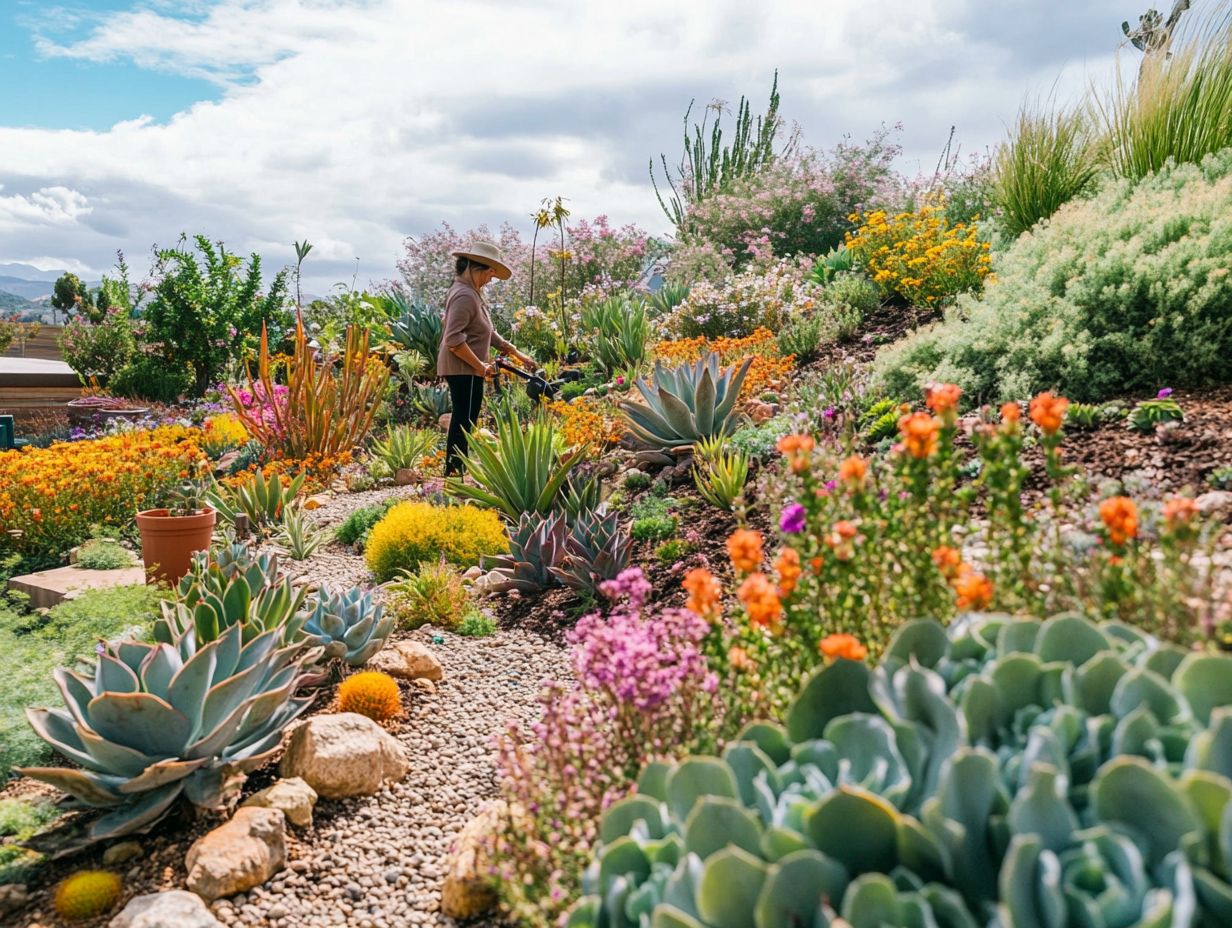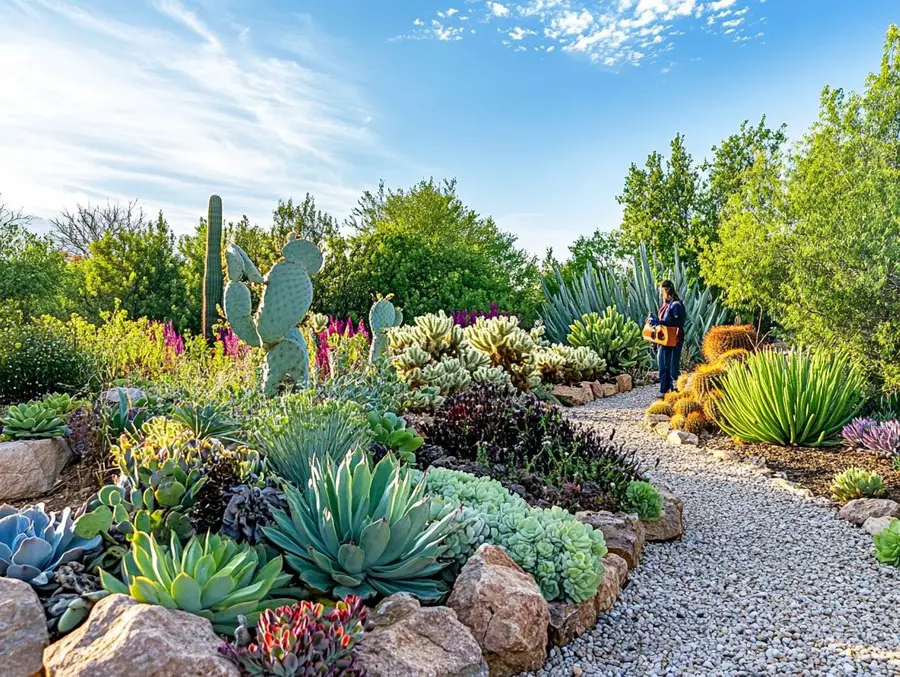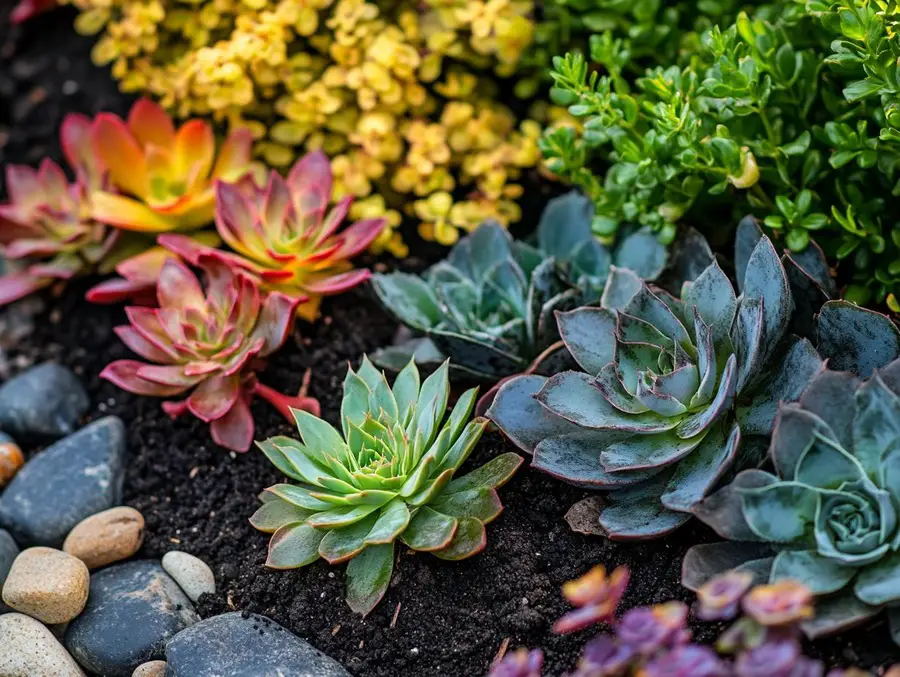We use affiliate links. If you purchase something using one of these links, we may receive compensation or commission.
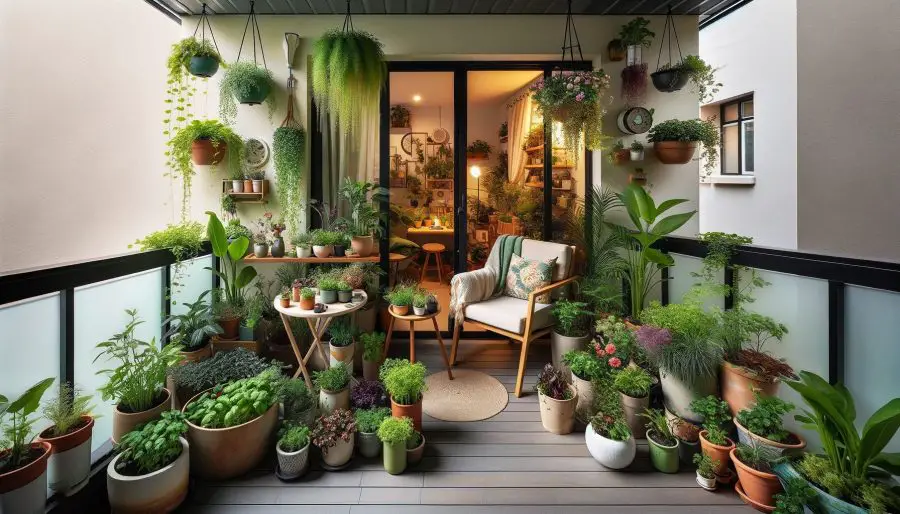
Discover the joys of apartment gardening! Our guide makes it easy to transform your space into a green haven, even in the smallest apartments.
Apartment Gardening Key Takeaways:
- Apartment gardening is the practice of growing plants within an apartment setting, using spaces like balconies, windowsills, or indoor areas.
- It often involves container gardening, vertical setups, and indoor plants, offering a way to garden in limited spaces.
Welcome to the world of apartment gardening, where every balcony and windowsill becomes a potential paradise!
Join us as we unravel the secrets to creating a lush, thriving garden in your very own apartment.
It’s simpler than you think, and we’re here to guide you every step of the way!
An Introduction to Apartment Gardening
Gardening isn’t just for those with sprawling backyards. Apartment dwellers, rejoice!
Your green thumb aspirations are about to take root, right in your living room or balcony.
Apartment gardening isn’t just a trend; it’s a lifestyle shift toward sustainable living, right in your urban dwelling.
Key Takeaways
- Discover the joys and benefits of nurturing a garden in limited spaces.
- Explore a variety of plants perfect for indoor and outdoor apartment settings.
- Learn crucial tips for maintaining your lush, compact green space.
Understanding Apartment Gardening
In this part, we’ll explore the basics of apartment gardening, from understanding its benefits to selecting the right plants for your space.
Whether you’re a beginner or looking to refine your gardening skills, these insights will set a solid foundation for your green endeavors.
Gardening is the practice of growing and cultivating plants as part of horticulture. In gardens, ornamental plants are often grown for their flowers, foliage, or overall appearance; useful plants, such as root vegetables, leaf vegetables, fruits, and herbs, are grown for consumption, for use as dyes, or for medicinal or cosmetic use.
Gardening ranges in scale from fruit orchards to long boulevard plantings with one or more different types of shrubs, trees, and herbaceous plants, to residential back gardens including lawns and foundation plantings, all the way to container gardens grown inside or outside.
Gardening may be very specialized, with only one type of plant grown, or involve a variety of plants in mixed plantings. It involves active participation in the growing of plants and tends to be labor-intensive, which differentiates it from farming or forestry. https://en.wikipedia.org/wiki/Gardening
The Benefits of Apartment Gardening
Apartment gardening transcends mere aesthetics. It’s a gateway to a healthier environment, purifying your indoor air with every leaf and bloom.
Plants like peace lilies and spider plants not only add visual appeal but also act as natural air filters.
Embracing apartment gardening brings numerous benefits, enhancing both your living space and well-being.
From air purification to the joy of growing your food, the advantages are as rewarding as they are diverse.
Getting Started: Space and Sunlight Considerations
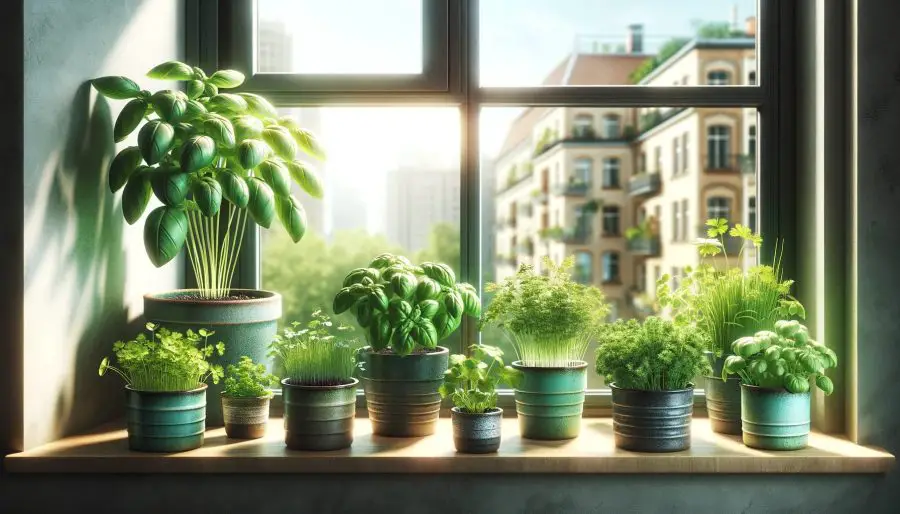
The key to a thriving apartment garden is understanding your space’s unique characteristics.
Light, space availability, and balcony usage are critical factors in determining what and how you can grow.
Space might seem like a luxury in apartments, but gardening is all about creativity.
Whether it’s a cozy balcony or a sunlit windowsill, every nook is an opportunity for growth.
You certainly can garden in an apartment without a balcony.
Understanding light levels is crucial. For instance, south-facing windows offer the brightest light, ideal for sun-loving herbs like thyme and rosemary.
Start an Apartment Herb Garden: Easy Tips and Tricks for Beginners
Choosing the Right Location
Selecting an optimal spot for your garden involves assessing light levels and available space.
South-facing windows are ideal for light-loving plants, while shaded areas can accommodate different plant types.
Selecting Plants for Indoor Apartment Gardens
Choosing the right plants for your indoor environment is crucial.
Factors like light availability, space, and your lifestyle play significant roles in determining which plants will thrive in your apartment.
Your indoor garden can be a mix of aesthetics and utility. From air-purifying plants to edible herbs, the choices are abundant.
Consider low-maintenance options like basil, cilantro, and mint to start your green journey.
Indoor Plant Varieties
Choosing the right plants is a critical step in apartment gardening.
Indoor environments offer unique conditions that are suitable for a variety of plants, ranging from those that are purely decorative to those that serve functional purposes like air purification or providing fresh herbs.
When selecting plants for your indoor garden, consider factors like available light, your lifestyle, and how much time you can dedicate to plant care.
Read more: 22 Best Low-Light Plants for Apartments
Here are some suggested plants that are well-suited for indoor conditions:
Decorative Plants:
- Fiddle Leaf Fig (Ficus lyrata): Known for its large, glossy leaves, it adds a dramatic touch to any room. It prefers bright, indirect light.
- Monstera Deliciosa: Often referred to as the “Swiss cheese plant” due to its unique leaf holes. Thrives in bright to medium indirect light.
- Rubber Plant (Ficus elastica): With its dark green leaves and robust size, it makes a striking addition to any space. Prefers bright, indirect light.
Air-Purifying Plants:
- Spider Plant (Chlorophytum comosum): Easy to grow and known for its air-purifying qualities. Thrives in bright to moderate indirect light.
- Peace Lily (Spathiphyllum): Not only does it purify the air, but it also blooms beautiful white flowers. Prefers low to medium light.
- Snake Plant (Sansevieria): Extremely hardy and effective at filtering indoor air. Can tolerate low light conditions.
Low-Maintenance Plants:
- Pothos (Epipremnum aureum): A hardy vine that can thrive even in low light and irregular watering conditions.
- ZZ Plant (Zamioculcas zamiifolia): Known for its ability to survive with minimal care, making it perfect for busy gardeners.
- Cast Iron Plant (Aspidistra elatior): True to its name, it’s tough and can tolerate a range of conditions, from low light to infrequent watering.
Edible and Herbal Plants:
- Basil: Requires a bit more care with regular watering and bright light but is a wonderful culinary herb.
- Mint: Grows quickly and easily, perfect for adding fresh flavor to drinks and dishes.
- Cilantro: Loves bright light and adds fresh flavor to a variety of cuisines.
Flowering Plants:
- African Violets (Saintpaulia): Small and colorful, these plants can bloom even in indoor conditions with proper care.
- Orchids: With a bit more care, they can provide beautiful blooms that last for weeks.
- Anthurium: Known for its bright red, heart-shaped flowers and glossy green leaves.
These plants offer a range of options for indoor gardeners, catering to different needs and preferences.
Whether you’re looking for something easy and low-maintenance or something that adds a pop of color and life to your space, there’s an indoor plant that can fit the bill.
Remember, the key to successful indoor gardening is understanding the specific needs of each plant and providing the right environment for it to thrive.
Ideas for Outdoor Apartment Gardens
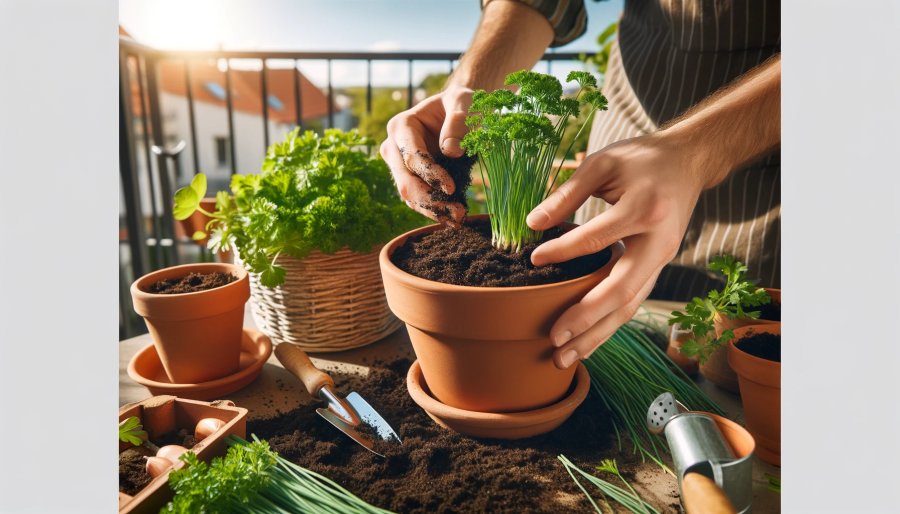
For those with balconies or small outdoor areas, creating an outdoor garden brings a piece of nature to your urban dwelling.
This section explores the possibilities of transforming these spaces into vibrant gardens.
Don’t let a small balcony limit your gardening dreams.
Compact dwarf varieties of fruits and vegetables can thrive in such spaces.
Consider vertical gardening to maximize space and add a touch of beauty with flowering vines like Mandevilla or Morning Glory.
H3: Plant Choices for Limited Outdoor Spaces
When it comes to balcony or small outdoor space gardening, the key is selecting plants that are well-suited to the conditions of your space, particularly in terms of size, light requirements, and maintenance needs.
Balcony gardens offer the opportunity to grow a variety of plants, ranging from decorative flowering varieties to practical edible ones. Here’s a list of plants that typically thrive in such environments:
Edible Plants:
- Herbs: Compact and easy to grow, herbs like rosemary, thyme, and basil are perfect for balconies.
- Tomatoes: Dwarf or cherry tomato varieties are suitable for pots and can thrive in sunny balcony conditions.
- Strawberries: Ideal for containers, strawberries can be grown in hanging baskets or pots.
- Peppers: Small varieties of peppers, both sweet and hot, can be grown in pots on sunny balconies.
- Salad Greens: Lettuce, spinach, and arugula can be grown in shallow containers and harvested fresh for salads.
Flowering Plants:
- Petunias: Known for their vibrant colors, petunias can add a splash of brightness to any balcony.
- Geraniums: Hardy and easy to care for, geraniums are ideal for sunny balconies.
- Begonias: Offering beautiful flowers, begonias can do well in both sun and partial shade.
- Marigolds: Not only do they provide colorful blooms, but marigolds also help repel certain pests.
Fruit Bushes and Dwarf Trees:
- Blueberry Bushes: Dwarf varieties can be grown in pots, provided they get enough sun.
- Lemon Trees: Dwarf lemon trees can thrive in large pots on sunny balconies.
- Dwarf Apple Trees: Some dwarf apple tree varieties are suitable for container growing.
Climbing Plants:
- Jasmine: This fragrant plant can be trained to climb balcony railings or trellises.
- Ivy: Ideal for creating a green wall, ivy thrives in both sun and shade.
- Clematis: Known for its beautiful flowers, clematis can climb up trellises or balcony railings.
Shade-Loving Plants:
- Ferns: Great for shady spots, ferns add lush greenery to your balcony garden.
- Hostas: These leafy plants do well in shade and add texture to your plant arrangement.
- Impatiens: Known for their colorful blooms, impatiens are ideal for shady balcony areas.
When choosing plants for your balcony or small outdoor space, it’s important to consider the weight and size of the containers, as well as the weight capacity of your balcony.
Ensure proper drainage in the pots to avoid waterlogging, and be mindful of the growth habits and care needs of each plant.
With the right plant choices, you can transform your limited outdoor space into a vibrant, green oasis.
Essential Care and Maintenance for Indoor Gardens
Proper care and maintenance are vital for a flourishing indoor garden.
This section will guide you through the basics of keeping your indoor plants healthy and thriving.
Indoor gardens require attention to thrive. Regular watering, ensuring adequate light, and maintaining soil quality is key.
Cacti and succulents are great for those often away, offering a green oasis without daily upkeep.
Basic Care Tips
Creating a thriving indoor garden involves more than just placing plants in pots.
Understanding and providing the basic needs of your plants is crucial.
These needs include regular watering, adequate light, and the right soil.
Here’s a guide to help you create and maintain an optimal environment for your indoor garden:
Regular Watering:
- Understand Plant Needs: Different plants have varying water requirements. While some plants prefer consistently moist soil, others thrive in drier conditions.
- Check Soil Moisture: Before watering, check the soil moisture. A simple method is to stick your finger about an inch into the soil. If it feels dry, it’s time to water.
- Water Thoroughly: When watering, do so thoroughly until water runs out of the drainage holes. This ensures the entire root system gets moisture.
- Avoid Overwatering: Overwatering can lead to root rot, one of the most common problems in indoor gardening. Allow the topsoil to dry out slightly between watering.
Ensuring Adequate Light:
- Know Your Plant’s Light Requirements: Some plants require bright, indirect light, while others can tolerate lower light conditions.
- Use Natural Light Wisely: Place plants near windows where they can receive appropriate amounts of natural light. Rotate plants regularly to ensure even exposure.
- Supplement with Artificial Light: In cases where natural light is insufficient, consider using grow lights to provide the necessary spectrum for plant growth.
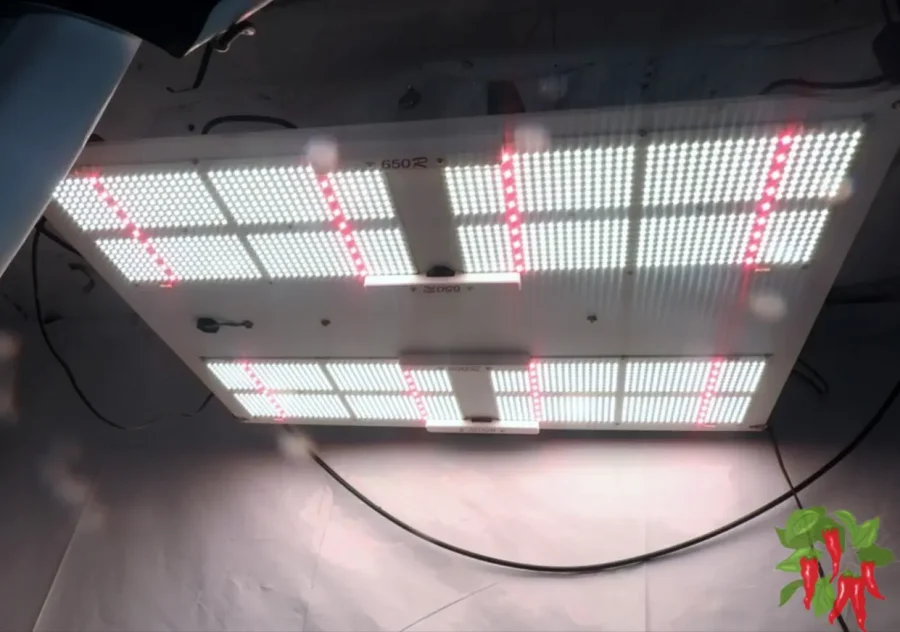
Choosing the Right Soil:
- Use Potting Mix: Garden soil is not suitable for indoor plants as it may contain pathogens and doesn’t drain well. Use a good-quality potting mix that provides proper drainage and aeration.
- Consider Plant-Specific Mixes: Some plants, like orchids or cacti, thrive in specialized soil mixes tailored to their needs.
- Refresh Soil Regularly: Over time, potting soil can become compacted or depleted of nutrients. Repot plants every couple of years or refresh the top layer of soil annually.
Humidity and Temperature:
- Maintain Humidity Levels: Many indoor plants, particularly tropical varieties, prefer higher humidity levels. You can increase humidity by misting plants, using a humidifier, or placing a water tray near the plants.
- Avoid Temperature Extremes: Keep plants away from cold drafts and direct heat sources. Most indoor plants prefer a consistent temperature that mimics their natural environment.
Fertilization:
- Feed Regularly: Indoor plants need nutrients to grow. Use a balanced, water-soluble fertilizer during the growing season, following the recommended frequency and dosage.
- Adjust for Seasons: Reduce or stop fertilizing in the winter months when plant growth typically slows down.
By following these basic care tips, you can ensure that your indoor plants not only survive but thrive, bringing life and beauty to your indoor garden.
Remember, regular observation and attention to your plants’ needs are key to successful indoor gardening.
Advancing Your Apartment Gardening Skills
Here we delve into more advanced topics, including outdoor gardening care and innovative gardening techniques. These insights will help you expand your gardening expertise and explore new possibilities.
Outdoor Apartment Garden Care
Caring for an outdoor apartment garden has its unique challenges and rewards. From dealing with weather elements to maximizing limited space, these tips will help you nurture a thriving outdoor garden.
Outdoor gardening in an apartment setting presents a unique set of challenges and opportunities.
From building raised beds for concrete balconies to understanding the right conditions for your plants, it’s all about making the most of your available space.
Remember, even a small balcony can become a lush, productive garden with the right care and planning.
Overcoming Outdoor Gardening Challenges
Overcoming the challenges of outdoor apartment gardening requires adaptability and creativity.
Weather conditions are a significant factor; you’ll need to consider how elements like wind, rain, and sunlight affect your plants.
In windier locales, choose plants that are more robust and can withstand gusts, or use windbreaks to protect more delicate varieties.
For rainy areas, ensure proper drainage in your planters to avoid waterlogged soil, which can harm plant roots.
Space limitations call for efficient use of every inch.
Optimize your balcony or patio with vertical gardening techniques, hanging planters, or tiered shelving units.
This approach not only saves space but also adds an aesthetic appeal to your outdoor area.
Choosing the Right Plants
Choosing the right plants is crucial for a successful outdoor garden in an apartment setting.
Assess the sunlight exposure of your space and select plants that thrive in those conditions.
Full-sun environments are great for vegetables like tomatoes and peppers, while shade-tolerant plants like ferns and hostas are better for low-light areas.
Consider the local climate as well; some plants are better suited to specific temperature ranges and seasonal changes.
Weight Considerations
Consider the weight and size of containers and plants, especially in balcony gardens.
Ensure that your balcony can safely support the weight of your garden, particularly when the soil is wet.
Use lightweight containers and avoid overloading any single area.
By understanding and adapting to these challenges, you can create a thriving outdoor garden that enhances your apartment living experience, providing a refreshing touch of nature right outside your door.
Innovative Apartment Gardening Ideas
Innovation in gardening opens up new opportunities for apartment dwellers.
This section explores creative and modern approaches to gardening within the confines of an apartment.
Expand your gardening horizons with some innovative ideas.
Hydroponic systems, for instance, offer a soil-free way to grow plants, perfect for indoor spaces.
Or, why not transform your bathroom into a humid haven for tropical plants?
These creative approaches let you enjoy gardening in any part of your apartment.
Creative Gardening Solutions
In the quest for greenery within the confines of an apartment, creative gardening solutions like hydroponics and terrariums offer exciting alternatives to traditional methods. These innovative approaches are not just space-savers; they also introduce a modern twist to apartment gardening, making it accessible and enjoyable even for those with limited space or experience.
Hydroponics
Hydroponics, a soil-less method of gardening, utilizes a water-based nutrient-rich solution to grow plants.
This technique is perfect for apartments as it eliminates the mess of soil and can be set up in various sizes, from small tabletop systems to larger, free-standing units.
It’s ideal for growing herbs, leafy greens, and even some fruits and vegetables.
Hydroponic systems are also known for faster plant growth and higher yields, making them an efficient method of gardening in small spaces.
Terrariums
Terrariums, on the other hand, are like miniature ecosystems enclosed in glass containers.
They are not only a gardening solution but also a decorative element that adds a touch of nature’s art to your living space.
Terrariums can house a variety of plants, from succulents and cacti to tropical plants, depending on the type of environment you create (open or closed).
They are low-maintenance, requiring minimal watering and care, and are an excellent choice for those new to gardening or with busy lifestyles.
Creative Gardening Solutions
These creative gardening solutions offer fresh perspectives on cultivating plants in apartments.
They allow urban dwellers to experiment with gardening in a way that suits their space and lifestyle, making the process of growing plants not just feasible but also a delightful and fulfilling hobby.
By embracing these innovative methods, you can turn any small space into a vibrant, green oasis.
Community Gardening: Extending Beyond Your Apartment
Community gardens present an opportunity to extend your gardening passion beyond your apartment.
They offer additional space, shared resources, and a sense of community.
If your apartment gardening aspirations outgrow your personal space, consider joining or starting a community garden.
These communal spaces offer not just more room to grow but also a chance to connect with fellow gardening enthusiasts.
You’ll share knowledge, resources, and the joy of harvesting together.
Engaging in Community Gardening
Engaging in community gardening offers a multitude of benefits, especially for apartment dwellers with limited space.
These communal spaces provide an opportunity to cultivate a wider variety of plants, including larger crops that might not be feasible in a small apartment setting.
But beyond the practical advantages, community gardens foster a sense of community, connection, and shared learning.
Finding a Community Garden
To get started with community gardening, first, locate a garden near you. Many cities and towns have public community gardens where you can rent a plot.
Check with local community centers, gardening clubs, or municipal websites for information.
If there isn’t one nearby, consider starting one with your neighbors or local community members.
Know and Follow the Rules
Once you have a plot, it’s essential to understand the rules and guidelines of the garden.
These might include regulations about the types of plants you can grow, organic gardening practices, or maintenance responsibilities.
Respect these guidelines to ensure a harmonious and productive community garden experience.
Sharing Knowledge
Community gardening is also about collaboration and sharing knowledge.
Engage with fellow gardeners, share tips and experiences, and be open to learning from others.
Participating in workdays or community meetings can enhance your gardening knowledge and skills.
Local Food Security
Additionally, community gardens often play a role in local food security and sustainability efforts.
They can be a source of fresh produce for neighborhood food banks or local markets.
Participating in such initiatives can be incredibly rewarding, as it allows you to contribute positively to your community.
Community Connections
In summary, community gardening is a rewarding endeavor that goes beyond just gardening.
It’s an avenue for expanding your gardening space, learning new techniques, and building community ties.
It’s a fulfilling way to connect with nature, people, and the broader goal of creating sustainable, green spaces in urban areas.
Extending Your Green Space: Advanced Apartment Gardening Techniques
In this section, we dive deeper into innovative techniques to enhance your apartment gardening experience.
From maximizing space to balancing aesthetics with functionality, these advanced methods will help you create a more efficient and beautiful garden in your apartment.
Maximizing Space with Vertical Gardening
In the compact realms of apartment living, vertical gardening emerges as a creative and space-saving solution.
It’s an innovative approach that turns walls and balconies into vibrant green canvases, offering a way to grow a variety of plants without sacrificing valuable floor space.
This section delves into how you can effectively utilize vertical spaces for gardening, transforming your apartment into a lush, vertical oasis.
We’ll explore practical ideas and tips for setting up vertical gardens, including the selection of suitable plants and the use of various structures like trellises and hanging planters.
Whether you’re looking to grow decorative plants, herbs, or even small vegetables, vertical gardening opens up a new dimension of possibilities in apartment gardening.
Utilizing Walls and Balconies
Vertical gardening is a game-changer for apartment dwellers with limited space.
By using walls and balconies, you can create lush green areas without sacrificing floor space.
Install trellises against walls or hang planters from balcony railings to grow climbing plants, herbs, and small vegetables.
The Art of Container Gardening in Apartments
Container gardening is a cornerstone of apartment gardening, offering incredible versatility and adaptability for urban greenthumbs.
This method is particularly well-suited for apartment settings, where space is at a premium, and the ability to move plants to optimize light and space is essential.
Whether you’re dealing with a small balcony, a sunny windowsill, or even just a corner of your living room, container gardening allows you to bring nature into your home in a manageable and beautiful way.
Container Gardening Advantages
The beauty of container gardening lies in its simplicity and flexibility.
Aesthetics
You can choose containers that fit your space and style, from classic terracotta pots to modern geometric planters.
This approach allows you to create a garden that’s not only functional but also complements your home’s decor.
Flexibility
Containers can be easily moved to take advantage of changing sunlight patterns throughout the day and seasons, ensuring that your plants receive the light they need to thrive.
Control
Another advantage of container gardening is the control it offers over the growing environment.
You can tailor the soil mix to the specific needs of each plant, ensuring optimal growth.
It also allows for better control of water, nutrients, and root growth. This level of control is particularly beneficial for growing vegetables and herbs, as it can lead to healthier plants and more abundant harvests.
New Possibilities
Container gardening also opens up a world of creative possibilities. You can experiment with different plant combinations, creating visually appealing arrangements that bring color and life to your space.
From lush foliage plants to vibrant flowers and edible herbs, the options are endless.
You can even explore vertical gardening by stacking containers or using wall-mounted or hanging planters to maximize your space.
In summary, container gardening is an art form that empowers apartment dwellers to cultivate their own patches of greenery.
It’s an accessible, flexible, and rewarding way to garden in small spaces, bringing the joy of growing plants into any home, regardless of size.
Selecting the Right Containers
The foundation of successful container gardening lies in choosing the right containers, which play a crucial role in the health and growth of your plants.
The first and foremost consideration is ensuring adequate drainage. Containers should have holes at the bottom or in the sides to allow excess water to escape.
This prevents waterlogging, a common issue in container gardening that can lead to root rot and other plant diseases.
Choosing Container Materials
When selecting containers, material and size are also important factors.
Different materials such as terracotta, plastic, ceramic, or metal have varying effects on soil moisture and temperature.
For example, terracotta is porous and allows the soil to breathe, but it also means the soil dries out faster.
Plastic and glazed ceramic pots retain moisture better, which can be beneficial for plants that require a consistently moist environment.
Container Size
Size matters too. Larger containers hold more soil and, consequently, retain moisture for longer and provide more room for root growth.
This is particularly important for plants with extensive root systems or those that grow rapidly.
Conversely, smaller containers are suitable for herbs and plants with shallower roots.
They’re also easier to move around, giving you the flexibility to optimize sunlight exposure.
Container Aesthetics
Creativity in container choice can add a unique aesthetic to your garden.
Repurposing items like old cans, buckets, wooden crates, or even boots and kettles can add a personal touch and character.
This not only recycles materials but also adds an eclectic charm to your gardening space.
When repurposing items, ensure they are safe for plants by cleaning them thoroughly and creating drainage holes.
Container Weight
Additionally, consider the weight of the container, especially if you plan to place it on a balcony or windowsill.
Ensure the structure can safely support the weight of the container, soil, and plants, particularly when wet.
In summary, selecting the right containers is a balance of functionality, aesthetics, and practicality.
By choosing containers with good drainage, considering the material and size, and getting creative with repurposing, you can set the stage for a thriving and visually appealing container garden in your apartment.
Best Plants for Container Gardening
Container gardening opens up a world of possibilities for growing a variety of plants, even in limited spaces.
Certain plants are particularly well-suited to container life due to their growth habits and space requirements.
Here’s a list of some of the best plants for container gardening, including both edible and ornamental options, along with suggestions for easy beginner plants:
Edible Plants for Containers:
- Cherry Tomatoes: Ideal for containers due to their compact size. They need plenty of sunlight and regular watering.
- Dwarf Peppers: Both sweet and hot varieties do well in pots. They require warm conditions and consistent moisture.
- Lettuce Varieties: Lettuce grows quickly and doesn’t require deep containers, making it perfect for shallow pots.
- Herbs: Basil, cilantro, parsley, and chives are excellent for beginners. They need good light and regular harvesting to encourage growth.
- Strawberries: A delightful addition to any container garden. They prefer sunny spots and well-drained soil.
- Radishes: Fast-growing and easy, radishes are ideal for beginners and can be grown in small, shallow containers.
Ornamental Plants for Containers:
- Petunias: These vibrant flowers are excellent for adding color to your space. They thrive in sunny conditions.
- Geraniums: Hardy and easy to care for, geraniums are ideal for beginner gardeners and offer beautiful blooms.
- Ferns: Great for shady balconies or areas with indirect light. They add a lush, green touch to your space.
- Succulents and Cacti: Perfect for those who prefer low-maintenance plants. They require minimal watering and thrive in well-drained soil.
- Marigolds: Easy to grow and great for adding a pop of color. They also help deter pests, making them a practical choice.
Easy Beginner Plants:
- Snake Plant: Very low maintenance, tolerates low light and irregular watering.
- Pothos: A hardy plant that grows well in a variety of lighting conditions and is effective at purifying indoor air.
- Spider Plant: Adaptable and easy to care for, with the added benefit of producing baby plants that can be repotted.
- Aloe Vera: Requires minimal care, thrives in sunny conditions, and has the added benefit of medicinal properties.
- Peace Lily: Ideal for indoor environments, requiring low to moderate light and minimal watering.
When choosing plants for container gardening, consider the conditions of your space – the amount of sunlight, the climate, and the size of your containers.
By selecting the right plants, you can create a thriving garden that suits your environment and gardening experience level.
Balancing Aesthetics and Functionality
In apartment gardening, the challenge often lies in creating a space where functionality and aesthetics harmoniously coexist.
This balance is essential, as your garden should not only provide tangible benefits like fresh herbs or air purification but also serve as a visually appealing element that enhances your living environment.
Achieving this equilibrium involves thoughtful plant selection, strategic placement, and creative use of available space.
Aesthetic Considerations:
Your garden should be a reflection of your personal style and complement the overall decor of your apartment.
Consider the color palette of your plants and how they match or contrast with your interior design.
Use planters and containers that align with your decor style, be it modern, bohemian, rustic, or minimalist.
Think about how the shapes and textures of plants can add visual interest and depth to your space.
Tall, leafy plants can create an eye-catching focal point while trailing plants like ivy or string of pearls can add elegance and soften edges.
Functional Aspects:
Beyond their decorative value, plants in an apartment garden should serve a purpose.
Edible plants like herbs, small vegetables, and fruits bring the joy of homegrown produce to your kitchen.
Consider plants with air-purifying qualities, such as snake plants, spider plants, or peace lilies, to improve indoor air quality.
If you have limited space, opt for multi-functional plants that offer both aesthetic and practical benefits.
Spatial Dynamics:
Incorporating greenery into your apartment requires smart use of space.
Vertical gardens, hanging planters, and wall-mounted shelves are excellent ways to add plants without sacrificing floor space.
Consider the flow of your space and place plants in areas where they won’t obstruct movement but can still be appreciated and tended to easily.
Utilize windowsills, balconies, or even small corners that receive adequate light.
Plant Care and Maintenance:
Maintaining a balance also means choosing plants that fit your lifestyle and gardening capabilities.
If you’re new to gardening or have a busy schedule, low-maintenance plants are a wise choice.
Ensure that your plants receive the right amount of light, water, and nutrients for optimal growth.
Regular pruning, repotting, and health checks will keep your garden looking beautiful and thriving.
In summary, balancing aesthetics and functionality in apartment gardening involves a blend of design sensibility, practical gardening, and spatial awareness.
By carefully selecting and positioning plants, you can transform your apartment into a lush, productive, and aesthetically pleasing space that enhances your everyday living experience.
Decorative Plants That Purify Air
Incorporating plants that purify air into your apartment gardening not only enhances the visual appeal of your space but also contributes to a healthier living environment.
These plants act as natural air filters, removing common household toxins and improving indoor air quality.
They are an ideal combination of beauty and functionality, bringing a refreshing touch of nature indoors.
List of Air-Purifying Plants:
- Snake Plant (Sansevieria): Known for its striking, upright leaves, the snake plant is highly effective at filtering out toxins like formaldehyde, xylene, and toluene. It’s also one of the few plants that release oxygen at night, making it a great choice for bedrooms.
- Aloe Vera: Famous for its medicinal properties, aloe vera also purifies air by absorbing carbon dioxide and providing oxygen. It’s particularly good at filtering out formaldehyde and benzene.
- Spider Plant (Chlorophytum comosum): With its arching leaves and small white flowers, the spider plant combats pollutants including carbon monoxide and xylene. It’s also non-toxic to pets, making it a safe choice for pet owners.
- Peace Lily (Spathiphyllum): This elegant plant with its white blooms helps remove ammonia, benzene, formaldehyde, and trichloroethylene from the air. Peace lilies prefer shady areas, making them ideal for rooms with less natural light.
- Boston Fern (Nephrolepis exaltata): Known for its lush, feathery fronds, the Boston Fern is a natural humidifier and can help remove formaldehyde and xylene from indoor air.
- Rubber Plant (Ficus elastica): With its large, glossy leaves, the rubber plant is effective at filtering out airborne toxins and is particularly good at removing formaldehyde.
- Bamboo Palm (Chamaedorea seifrizii): This small palm thrives in shady indoor spaces and excels at filtering out benzene, formaldehyde, and trichloroethylene.
- English Ivy (Hedera helix): This versatile plant is known for reducing airborne fecal particles and filtering out formaldehyde. It’s an excellent choice for hanging baskets or as a climbing plant.
- Philodendrons: With their heart-shaped leaves, philodendrons are not only visually appealing but also adept at absorbing formaldehyde. They’re easy to care for, making them ideal for novice gardeners.
- Gerbera Daisy (Gerbera jamesonii): This bright and cheerful plant is effective at removing trichloroethylene and benzene, often found in inks. Place it in a spot that gets plenty of light to keep the flowers blooming.
Each of these plants brings its unique style and air-purifying abilities to your apartment garden.
By choosing a variety of these plants, you can create an aesthetically pleasing environment that also promotes better air quality and overall well-being.
Remember to consider the light and water requirements of each plant to ensure they thrive in your space.
Read more about the best pet-safe plants for apartments.
Growing Edible Plants Indoors
Indoor gardening isn’t just about ornamental plants; it’s also an opportunity to grow your own fresh, flavorful herbs and vegetables.
Having a range of edible plants indoors not only enhances your cooking with fresh ingredients but also provides a rewarding gardening experience.
Herbs are particularly well-suited for indoor cultivation as they generally require less space and can thrive on windowsills.
Small vegetable varieties can also be successfully grown in pots, bringing the joy of vegetable gardening into your apartment.
List of Edible Plants Suitable for Indoor Gardening:
-
Herbs:
- Basil: Thrives in bright light and warmth, perfect for pasta dishes and pesto.
- Mint: Grows quickly in moderate light, ideal for teas and garnishes.
- Cilantro: Prefers cooler temperatures and moderate light, great for fresh salsas and salads.
- Parsley: Needs some sunlight, versatile in various cuisines.
- Chives: Easy to grow, requiring minimal space and moderate sunlight.
- Oregano: A Mediterranean herb that does well in bright light, excellent for Italian and Greek dishes.
-
Vegetables:
- Cherry Tomatoes: Require a sunny spot and a bit more space but are very rewarding with their sweet fruit.
- Dwarf Chili Plants: Ideal for adding spice to dishes, these can grow in smaller pots with plenty of sunlight.
- Lettuce and Salad Greens: Fast-growing and can be harvested multiple times, perfect for a continuous supply of fresh greens.
- Radishes: Quick to grow and do not require deep soil, making them suitable for shallow containers.
- Carrots (Mini or Baby Varieties): Can be grown in deeper pots, prefer good sunlight.
- Green Onions: Easy to grow from scraps, requiring minimal space and care.
-
Fruit:
- Strawberries: Can be grown in hanging baskets or pots, need plenty of sunlight.
- Lemons (Dwarf Varieties): Require a sunny spot and regular watering but are a delightful addition to your indoor garden.
When growing edible plants indoors, consider the specific light, water, and soil requirements for each plant.
Herbs generally prefer well-draining soil and should not be overwatered.
Vegetables might need more space and deeper pots, especially root vegetables like carrots and radishes.
Fruit-bearing plants like tomatoes and strawberries require a good amount of sunlight to produce fruit.
Additionally, ensure that your indoor edible plants are free from harmful pesticides or chemicals, making them safe for consumption.
Growing your own herbs and vegetables indoors is not only a practical approach to gardening in small spaces but also a fulfilling way to enhance your culinary creations right from your windowsill.
Overcoming Challenges in Apartment Gardening
Apartment gardening, while rewarding, comes with its own set of unique challenges.
Limited space, varying light conditions, and indoor climate can all impact the health and growth of your plants.
Understanding how to navigate these challenges is key to maintaining a thriving indoor garden.
In this section, we’ll explore effective strategies for dealing with common issues like limited light and pest management.
Dealing with Limited Light
Light is a fundamental element for plant growth, but in an apartment setting, ensuring adequate light can be a challenge. Here’s how to address this issue:
- Grow Lights: For areas with insufficient natural light, grow lights are an excellent solution. They mimic the spectrum of sunlight, providing the energy your plants need for photosynthesis. LED grow lights are energy-efficient and can be adjusted to suit different plant types.
- Reflective Surfaces: Use mirrors or reflective wall paint to increase light exposure. Placing reflective surfaces near your plants can help bounce light around, ensuring more even light distribution.
- Rotating Plants: Regularly rotate your plants to ensure all sides receive equal light, promoting uniform growth and preventing leaning towards the light source.
- Choosing Low-Light Plants: If your apartment doesn’t get much natural light, opt for plants that thrive in low-light conditions, such as ferns, pothos, and philodendrons.
Managing Plant Health and Pests
Keeping your plants healthy is the best defense against pests and diseases. Here are some strategies for maintaining plant health:
- Regular Inspection: Frequently check your plants for signs of pests or diseases. Early detection is key to preventing the spread and serious damage.
- Organic Pest Control: Opt for organic methods to tackle pests. Neem oil, insecticidal soaps, and diatomaceous earth are effective and environmentally friendly options.
- Proper Watering: Overwatering can lead to root rot and under-watering can stress plants, making them more susceptible to pests. Ensure you’re providing the right amount of water based on each plant’s needs.
- Adequate Nutrition: Use organic fertilizers to nourish your plants. Healthy plants are more resistant to pests and diseases.
- Air Circulation: Good airflow helps prevent fungal infections. Ensure your plants aren’t overcrowded and consider using a small fan to improve air circulation.
- Quarantine New Plants: When introducing new plants to your apartment, quarantine them for a few weeks to ensure they don’t bring in pests.
- Cleanliness: Keep your gardening area clean. Remove dead leaves and debris that can harbor pests or diseases.
By understanding and implementing these strategies, you can successfully overcome the challenges of apartment gardening.
Creating a thriving indoor garden requires patience, observation, and a bit of creativity, but the rewards of a lush, healthy green space are well worth the effort.
Expanding Your Gardening Horizons
Embracing new methods and ideas is essential for any gardener, especially when working within the constraints of apartment spaces.
This section delves into how the integration of technology and the power of community can significantly elevate your apartment gardening experience, offering innovative solutions and expanding your horizons beyond traditional gardening practices.
The Role of Technology in Apartment Gardening
The integration of technology in gardening has revolutionized how we approach growing plants, especially in confined spaces like apartments.
With the advent of various technological advancements, apartment gardening has become more accessible, efficient, and productive.
These technologies can compensate for environmental limitations typical in apartments, such as inadequate natural light or space constraints, and can greatly enhance the gardening experience for both novices and experienced gardeners.
Exploring Hydroponic Systems
Hydroponics is a prime example of how technology can transform apartment gardening.
This soilless method of growing plants in a water-based, nutrient-rich solution is particularly suited for indoor environments. It offers several advantages:
- Space Efficiency: Hydroponic systems are compact and can be set up in various sizes, making them ideal for small apartments. Vertical hydroponic systems, in particular, are great for maximizing space.
- Controlled Growth Environment: Hydroponics provides complete control over the nutrients and water your plants receive, leading to healthier plants and often more bountiful yields compared to traditional soil-based gardening.
- Reduced Water Usage: These systems are water-efficient, recycling and reusing water, which is beneficial for environmentally conscious gardeners.
- DIY and Commercial Systems: For those who love DIY projects, building a basic hydroponic system can be a fun and rewarding experience. Alternatively, there are numerous sophisticated commercial systems available, equipped with automated features like nutrient dosing and LED lighting, making it easier to maintain optimal growing conditions.
- Growing a Variety of Plants: Hydroponic systems are versatile and can be used to grow a wide range of plants, from leafy greens and herbs to fruits like strawberries and even dwarf tomato varieties.
- Year-Round Gardening: With hydroponics, you can grow plants indoors year-round, regardless of the outdoor weather conditions, providing a continuous supply of fresh produce.
By incorporating hydroponic systems into your apartment gardening, you can overcome many traditional gardening challenges, making it a highly rewarding and productive endeavor.
Whether you opt for a simple homemade setup or a more advanced commercial system, hydroponics opens up new possibilities for urban gardeners to grow fresh, healthy produce right in their homes.
Apartment Gardening FAQs
As you embark on your apartment gardening journey, you might find yourself brimming with questions about how to start, maintain, and flourish in this rewarding hobby.
Whether you’re dealing with limited space, light issues, or simply seeking the best plants to grow, having a reliable source of information is crucial.
This FAQs section is designed to address some of the most common and important questions about apartment gardening.
From choosing the right plants to troubleshooting common issues, we’ve gathered insights and expert advice to help you navigate the rewarding path of creating a vibrant garden in your apartment.
So, let’s dive into these frequently asked questions and unlock the secrets to a successful and thriving apartment garden.
Q: What are the best plants for a beginner in apartment gardening?
A: Start with low-maintenance plants like spider plants, peace lilies, basil, and cilantro. These are easy to care for and thrive in indoor conditions.
Q: How often should I water my indoor garden?
A: The watering frequency depends on the plant type. Generally, check the soil moisture and water when the top inch feels dry. Cacti and succulents require less frequent watering.
Q: Can I grow vegetables in my apartment garden?
A: Yes, many vegetables like cherry tomatoes, lettuce, and spinach can be grown in pots on balconies or windowsills. Ensure they receive adequate sunlight and care.
Q: What kind of containers should I use for apartment gardening?
A: Choose containers with good drainage to prevent root rot. Materials like plastic, terracotta, or glazed ceramic work well.
Consider the size and depth based on the plant’s root system. Repurposing items like cans or jars can also be a creative and sustainable option.
Q: Do I need special soil for my indoor plants?
A: Yes, use a high-quality potting mix instead of regular garden soil which will compact in the container and may harbor pests or diseases.
Potting mix is formulated to provide proper drainage and nutrient retention suited for container plants.
Some plants, like cacti or orchids, may require specialized soil mixes.
Q: How can I maximize plant growth in limited light conditions?
A: Opt for plants that thrive in low light, such as ferns or pothos. You can also use mirrors or reflective surfaces to increase light exposure. If natural light is insufficient, consider investing in LED grow lights.
Q: What are some common pests in apartment gardens, and how can I control them?
A: Common pests include aphids, spider mites, and mealybugs. Control them by regularly inspecting plants, washing leaves, or using organic insecticidal soaps. Neem oil is also an effective, natural option for pest control.
Q: Can herbs and vegetables be grown indoors year-round?
A: Yes, many herbs and vegetables can be grown indoors all year if they receive adequate light and care.
Herbs like basil, mint, and oregano, and vegetables like tomatoes and greens can thrive indoors with proper light, either natural or from grow lights.
Q: How do I know when to repot my plants?
A: Repot plants when they outgrow their current container, usually indicated by roots growing out of the drainage holes or circling the soil surface.
Spring is the best time to repot, as plants are entering a growth phase.
Q: Is it possible to compost in an apartment setting?
A: Yes, you can compost using small-scale indoor compost bins or worm composting systems.
These methods are odorless and suitable for apartment living, turning kitchen scraps into valuable plant nutrients.
Final Thoughts: Apartment Gardening and Growing Your Own Green World
As we conclude our exploration of apartment gardening, it’s clear that this form of gardening is more than just a hobby.
It’s a lifestyle choice that brings nature into your urban living space, offering both aesthetic beauty and a sense of personal achievement.
Growing your own green world in an apartment setting may come with its challenges, but it also provides unique opportunities to be creative, resourceful, and connected with nature.
Let’s reflect on the key takeaways and envision the possibilities that apartment gardening holds.
The Joy of Creating Life in Small Spaces
- Personal Oasis: Transforming your apartment into a green haven creates a personal sanctuary where you can relax and escape the hustle and bustle of city life.
- Space Utilization: Even the smallest spaces can be maximized for gardening, demonstrating that you don’t need a large yard to cultivate a thriving garden.
Environmental Impact and Sustainability
- Eco-Friendly Living: Apartment gardening contributes to a healthier environment by purifying the air and reducing your carbon footprint.
- Sustainable Practices: Embracing methods like composting kitchen scraps, using organic pest control, and conserving water makes your gardening practice more sustainable.
Health Benefits and Well-being
- Mental Health: Gardening is a therapeutic activity that can reduce stress, improve mood, and enhance overall mental well-being.
- Physical Health: Growing your own fruits, vegetables, and herbs ensures you have access to fresh, organic produce, contributing to a healthier diet.
Community and Connection
- Building Relationships: Engaging in community gardens or sharing your gardening experiences with others can foster a sense of community and belonging.
- Educational Opportunities: Apartment gardening offers continuous learning experiences, whether you’re a beginner or an experienced gardener.
The Future of Apartment Gardening
- Innovative Technologies: As gardening technology advances, apartment gardeners will have even more tools and resources at their disposal to enhance their gardening experience.
- Expanding Horizons: The growing popularity of apartment gardening promises a future where more people can experience the joys and benefits of growing plants, regardless of their living situation.
In summary, apartment gardening is a rewarding endeavor that enriches your living space, supports environmental sustainability, and promotes physical and mental well-being.
It’s about making the most of what you have, embracing the challenges, and enjoying the journey of creating your own slice of green paradise.
As you continue to grow your garden, remember that each plant is a testament to your care, dedication, and connection to the natural world.
Final Thoughts
As we wrap up, reflect on the journey of apartment gardening. It’s a fulfilling practice that brings beauty, relaxation, and a sense of accomplishment into your home.
Embracing apartment gardening can transform your living space into a green oasis.
It’s a rewarding journey, filled with learning and growth. Whether you’re growing herbs for your kitchen or creating a mini-jungle for relaxation, the possibilities are endless.
Don’t be afraid to start small and dream big. Remember, every plant you nurture adds a little more life and joy to your apartment.
Read more: Growing Bamboo in Pots Indoors: 9 Easy Tips for Beginners
Looking for a pet-safe houseplant? Check out Fittonia Indoor Care
Check out our Apartment Gardening Category for more reading.
Related Content
Visit my Amazon Influencer Page for videos and gardening products Grow Your Own Garden

